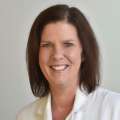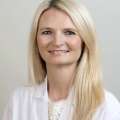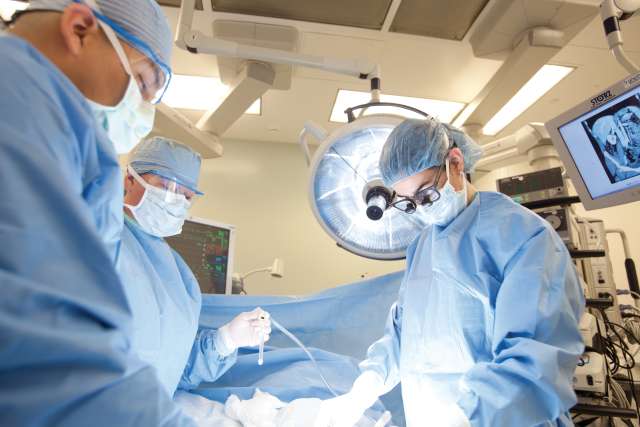Lori Jordan, a marketing executive for a Silicon Valley startup, was in her mid-30s when she noticed a lump in one of her breasts for the first time.
Although she had recently completed an annual physical and breast exam with her long-time primary care physician, , at , the lump was unmistakably large and smooth, and had obviously grown quickly. “I completely freaked out,” Jordan says.
She called Dr. Chirra the next morning and went into the office. An ultrasound revealed that this lump wasn’t anything to worry about, but was rather a fluid-filled cyst, which was drained with fine needle aspiration before Jordan was sent on her way.
But from that point on, Jordan, now 44, regularly developed additional cysts that were anywhere from 3 cm to 8 cm in size. Each time she felt a new lump or bump, she’d schedule an ultrasound right away to confirm that it was, in fact, benign, and that the fluid could be drained.
“The reality is that until I had an ultrasound,” says Jordan, who lives in the Central Coast community of Los Osos, “I didn’t know with any certainty that a new lump wasn’t something serious.”
At 41, she also had her first screening mammogram to look for any signs of breast cancer and get a baseline for future imaging studies. Everything checked out normal.
Another cyst, but more...
In late-April of 2017, when she was 42 years old, Jordan felt what was probably another large cyst in her left breast. As usual, she scheduled an ultrasound to confirm that it was not anything to worry about.
The mass was in fact a cyst, which was drained that day. Then Jordan also asked her physician to check out a smaller cyst on her right breast that had appeared many months prior. She figured that since she was already in the office, she should have it aspirated as well, but the ultrasound detected a suspicious mass deep in the dense breast tissue behind the cyst. Jordan opted to have a biopsy, in which cells are collected from that mass for testing, on the same day.
Her biopsy was on a Friday, Jordan says, and on Tuesday, Dr. Chirra told her the news—that the lab results confirmed the lump behind her cyst was actually cancer.
“Cysts don’t cause breast cancer,” Jordan says, “but they can mask other breast issues, or give you a false sense that because you’ve had benign cysts in the past, that’s all you’ll ever have.”
Because she was so diligent about having lumps imaged and examined every time they cropped up, Jordan says her doctors were able to catch her breast cancer early.
A team-based approach to care
Immediately after her diagnosis, Jordan says she wanted to get as much information as she could and determine her best course of action.
Dr. Chirra explained possible next steps and treatment options, including , in which patients can meet with the full team, including a breast surgeon, plastic surgeon, medical oncologist and radiation oncologist in the same day. This team approach and getting all of this information in one appointment appealed to Jordan, who scheduled her intake meeting for the following week.
The multidisciplinary UCLA Breast Center in Santa Monica, which started accepting patients in 2012, was designed to personalize breast cancer care and eliminate delays between a patient’s diagnosis and the start of treatment. It has expanded over the years, and now welcomes a new cohort of five to seven breast cancer patients every Wednesday.
“We know that patients with newly diagnosed breast cancer typically require multi-modality care given from a team of specialists, but this can be difficult and cumbersome to navigate on their own,” says radiation oncologist, . “This program gives them a specific place to start their journey, and get all of the information that they need in a timely fashion.”
On intake mornings, the physician team along with a radiologist and pathologist, reviews each patient’s imaging studies, pathology results and details of their medical history before they collectively decide how to proceed. “It’s incredibly valuable to all sit down together, look at each case from different perspectives, and then see each patient knowing we are all on the same page,” Dr. McCloskey says.
As the clinical discussion wraps up, new patients are checked in and are escorted to individual exam rooms. The physicians then come into the exam room one at a time to meet the patient and review their role in the treatment process. The first physician to meet the patient also introduces the big picture, holistic treatment plan, which in many cases means surgery followed by chemotherapy followed by radiation.
“When new patients come into the program, they may feel afraid or worried or confused,” says medical oncologist, Dr. Parvin Peddi. “Our goal is for each patient to understand the different elements of breast cancer treatment, as well as their individual recommended treatment approach, before they leave.”

In Jordan’s case, , the co-director of the Santa Monica Breast Center, met with her first. “When she entered the room, the first thing she said was, ‘OK, let’s get you healthy,’” Jordan remembers. “She has such a great bedside manner, and really set the tone for the day.”
Dr. Kusske says this is by design. “Psychologically, it’s beneficial for our patients to feel like they have a team that’s all on the same page working with them,” she says. “We want them to know that in most cases, breast cancer is very curable, but treatment involves multiple specialists, and we’re going to handle that coordination from the start.”
When she spoke with Jordan that day, Dr. Kusske explained the surgery and the additional genetic testing and imaging studies Jordan would need before she underwent this procedure. She also explained that the team didn’t know yet if she would need chemotherapy. They’d have to wait to see how surgery went, and do some follow-up testing on the tumor.
Jordan finally met , one of five plastic surgeons who is part of the program, to discuss her breast reconstruction options. While Jordan ultimately decided to have a double mastectomy and forego reconstruction, she says she found this one-hour consultation incredibly helpful, and the entire day empowering.
Dr. Peddi then provided some additional details about what chemotherapy might entail, if Jordan was to need it; and Dr. McCloskey walked her through the radiation process.
“I went from feeling directionless and not knowing what to do, to feeling really educated, and like I had this entire group of people ready to help,” Jordan says.
In fact, at one point in the day, she says, she remembers turning to her husband and saying something like, “‘Oh my gosh, we found our team.’ We just knew this was the right approach, and the right place to be.”
Treatment begins
With all of this information in hand, Jordan worked with a coordinator to schedule her follow-up MRI, complete her genetic testing, and book her breast surgery for a few weeks out.
Then, three days after that first appointment, she went off on a family vacation to celebrate her aunt and uncle’s 50th wedding anniversary to Vancouver Island, where she says she was surprisingly able to relax and have a good time.
Once she was back in town, Dr. Kusske performed Jordan’s breast surgery on May 25. After the procedure, the mass was sent off to pathology for testing, and Jordan spent one night in the hospital to recover. “I felt so happy when that part of my treatment was done,” she says.
Although the mass in Jordan’s breast had what’s known as “clean margins,” meaning that there were no cancer cells around it and her lymph nodes were clear, Dr. Peddi decided to run what’s called an Oncotype test to further analyze the tumor and its genetic makeup, and determine if chemotherapy might be helpful.
After considering the results of the OncotypeDx test, the extent of Jordan’s tumor (6 cm) and her young age (42), Dr. Peddi recommended four cycles of a personalized chemotherapy.
Jordan was thankful that she was able to complete this treatment, which started on June 30 and ended Sept. 21, in , rather than commute back and forth from Santa Monica to her Central Coast home.
While she was completing chemotherapy, Jordan, who is an avid hiker, stayed active. “I walked every single day,” she says, “even on my worst day. That helped a lot.”
She also maintained her interest in cooking and preparing healthy meals, and even found a cookbook with recipes that kept in mind the side effects of chemotherapy, including nausea, a sore mouth, and dulled taste buds, offering different recipes for different symptoms.
Once she’d completed chemotherapy, Jordan temporarily relocated to Santa Monica for six weeks so that she could undergo her .

On Nov. 8, she had her last radiation treatment; on Dec. 5, she started a long-term anti-cancer drug, called Tamoxifen; and soon after, she was told by Dr. Peddi that she was—and still is—considered cancer-free.
A business idea blooms
During her cancer treatment, Jordan says she always carried a journal with her to record notes, questions and important clinical information. The act of keeping a journal really helped her process how she was feeling, she says, but writing everything down also helped keep her organized, especially when she experienced some “chemo brain” during treatment.
Towards the end of her treatment she envisioned what a better, breast cancer-specific journal might look like. It would be something that patients could use during their treatment with places to record clinical information, such as medication doses and side effects, as well as one’s mood, with blank pages for free writing or doodling. Something that had “the comfort of the binder I was given at my first team appointment,” Jordan says, but was more compact, attractive and portable.
She did her research and saw that this was an untapped market and started working on prototypes for such a project, which members of her online breast cancer group critiqued as she went through development.

Six months after she was declared cancer-free, in the summer of 2018, she launched . Her plan is to turn the company into a non-profit by early-2020 so that anyone diagnosed with breast cancer who wants one of the specialized notebooks can get one for free.

Life today
Since completing her treatment almost two years ago, Jordan says that her life has pretty much returned to normal.
Because her tumor was estrogen-positive, meaning that the hormone helped it grow, she will take a maintenance anti-estrogen medication, called Tamoxifen, for the next five to 10 years to help wipe out any cancer cells that may not have been killed by chemotherapy, Dr. Peddi says.

She’ll also continues to see Dr. Peddi and Dr. McCloskey every six months for follow-up appointments, and continue to see Dr. Chirra each year for her annual physical.
Jordan says she’s back to hiking as often as possible in her beloved San Luis Obispo trails, and when possible, up in Big Sur.

And when she’s not working, hiking or developing Blink Journals, she’s turned her attention towards advocacy—starting with sharing her story and speaking to friends and family members about the importance of completing recommended cancer screenings and getting anything suspicious checked out in a timely manner.
“Because of my early diagnosis and positive outcome, I’m a huge advocate for people getting checked out if they notice any sort of change,” Jordan says. “I’m glad I was never willing to settle, and stayed on top of my screenings.”
More info: uclahealth.org/breasthealth | Phone: (424) 259-8791






